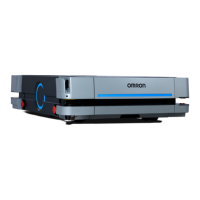Chapter 5: Payload Structures
l
AMR Coordinate System—The X,Y,Z, and Theta reference system relating the AMR to
its environment, and to the relative position of other devices such as the optional side
lasers. See: AMR Coordinate System on page 142.
Tilt Detection and Reporting
The tilt detection feature monitors the angle of the HD-1500 (with respect to flat ground) dur-
ing its operation. If the AMR tilts 60 degrees or more in any direction, an E-Stop occurs and
the power is discontinued to any user-supplied equipment. This will not prevent an improp-
erly loaded AMR from tipping over.
Safe Payload Placement
The following figures show the calculated safe CGplacements for HD-1500's maximum
allowed payload weight (1500 kg). The payload structure's CG must be within the area shown.
Assumptions in these calculations are:
l
The payload is securely attached to the AMR.
l
The payload does not overhang the AMR.
l The AMR does not exceed its specified default limits for:
o
Acceleration, deceleration, and velocity.
o
Angular velocity.
o
Coefficient of friction (0.6 min).
l
The casters and drive wheels are in good condition.
You must inspect the casters and drive wheels for signs of damage, excessive wear/tear,
or uneven spots as they could degrade the AMR stability.
In the following graphs:
l
X is the direction of the AMR's motion (rear to front).
l
Y is perpendicular to the AMR's direction of motion (side to side).
l
Z is the vertical dimension (height).
All units are in millimeters (mm). See also: AMR Coordinate System on page 142.
31500-000 Rev A HD-1500 Platform User's Manual 144

